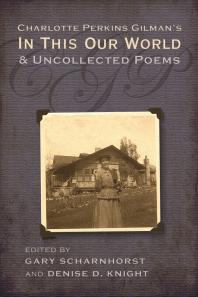“Peace then! Fear not the coming woman, brother!
Owning herself, she giveth all the more!
She shall be better woman, wife and mother,
Than man hath known before!”
Charlotte Perkins Gilman, “Reassurance,” In This Our World
Biographical Background
Unlike her peers, Gilman stood not only against the political and societal climate of the nineteenth century but, more prominently, against her own mind. Charlotte Perkins Gilman wrote much of In This Our World (1893) influenced by her family and personal trauma and guided by her endeavor for human independence and self-obtained happiness.
Gilman had strained family relations in both her adolescents and her adulthood. Gilman attributes much of her combined creativity and defiance to her father, Frederic Beecher Perkins. Gilman’s childhood with poor finances encouraged her activism for women’s financial independence.
In her marriage to Charles Walter Stetson, Gilman experienced among her struggles with mental illness. As a wife, Gilman learned of her displeasure to traditional domestic life and responsibilities. Soon after her divorce, Gilman moved to California, where she would enhance her writing career and make her place in history.
Despite her success in California and in her second marriage, Gilman suffered and eventually succumbed to her mental illness. While Gilman knew early in her marriage that she was discontent in the domestic lifestyle, the mundanity of domesticity dimmed after the birth of Gilman and Stetson’s daughter, Katharine. Katharine’s 1885 birth brought Gilman postpartum depression, making her feel like a failure as a mother and wife. After losing her daughter, Gilman saw a rise in popularity and a decline in her health. Towards the end of her life at the beginning of the twentieth century, Gilman learned she had terminal breast cancer. To end her battle with breast cancer, Gilman decided her surrender on her own terms and commit suicide.
Context
In the political and social spheres, Gilman made herself known as a progressive. Much like her father, Gilman was widely concerned with underdogs and those denied the help they most need. Gilman regularly contributed to political journals and magazines, such as Social Democrat to speak out against poor workers’ conditions.
Though Gilman made large strides in the fight for fair labor in America through her poetry and activism, the author is most well-known for her stance on the female experience. Though Gilman considered herself more of a humanist than a feminist, she dedicated much of her life and works to promoting female independence and agency
Outside of her personal life and its significant influence on In This Our World, the collection was partially shaped by Gilman’s literary influences. In terms of poetic convention, the collection adhered to some earlier writers’ trends and established styles. These influences include her aunt, Harriet Beecher Stowe, Walt Whitman, and Emily Dickinson.
In This Our World
In This Our World, Charlotte Perkins Gilman’s first poetry collection falls into the poetic genres of didactic poetry, rhyming poetry, and free verse poetry. This hybrid, as a result of Gilman’s personal growth, is collected in In This Our World to showcase Gilman’s influences and intentions for writing. Understanding how Gilman’s collection both differs and conforms to the generic conventions of didactic poetry, rhyming poetry, and free verse poetry helps readers better understand the world Gilman attempts to define, challenge, and reinvent.
Despite her controversial content on women’s independence, domestic choice, and mental illness and didactic method of communicating, In This Our World and much of Gilman’s work was well-received in the late nineteenth and early twentieth centuries. This is perhaps the result of Gilman publishing towards the end of the nineteenth century when prolific women writers already blazed a small trail for collections like In This Our World to filter through. Though her collection would not become as popular as “The Yellow Wallpaper,” Gilman’s poetry progressed a socially-proactive narrative in nineteenth and early-twentieth-century literature.
Gilman’s collection displays her ambition for universal equal opportunity in each of its three parts designated by Gilman’s priorities: nature in “The World,” feminism in “The Woman,” and politics in “The March.” Throughout her writing and lecturing career, Gilman encouraged the acceptance of male and female equality in multiple dimensions of her society. To Gilman, this included seeing men and women parallel to each other in terms of personal responsibilities and guaranteeing them the right to equal opportunity for personal growth. Gilman’s vision for this parallel, in this case, binary, gender structure is demonstrated in her “The World” section of In This Our World. In terms of late-nineteenth-century feminism, Gilman was liberal in her unapologetic work to increase the standard of living for people regardless of gender. Many contemporaries, however, did not share this view and denied women the basic right of personal autonomy and self-expression. The “feminist poems” in “The Woman” section of In This Our World offers a voice, or at least a platform, for women to express themselves and decide what they want for their own experience. The poems in “The Woman” either address women directly or have a woman as the subject, showcasing her own decisions and actions. In her poetic narrative, Gilman uses apostrophe and rhetorical questions to present women with choices perhaps not available in reality. While Gilman holds a distinguished legacy in literature, she also made significant strides in the political arena. Using her writing, Gilman took political stances, often speaking for workers’ and farmers’ labor rights. “The March” section of In This Our World is not an exception to Gilman using literature in this way.
Legacy
Behind the little-known poetry collection In This Our World is Charlotte Perkins Gilman: a writer, activist, mother, wife, woman, and person. While popular stories like “The Yellow Wallpaper” may be easily identified by the average twenty-first-century American, a whole other story is waiting to be discovered in the women behind influential stories. Gilman’s background and trauma influenced her poetry collection that reflects and presents much of her activism. In learning more about Gilman, one can learn more about mental health, feminism, and the human experience to better understand the moral teachings of the poetry collection.
Publications
Below is a PDF of Jill Rudd and Val Gough’s extensive Charlotte Perkins Gilman bibliography.
Charlotte Perkins Gilman: Optimist Reformer, edited by Jill Rudd, and Val Gough, University of Iowa Press, 1999. ProQuest Ebook Central, https://ebookcentral.proquest.com/lib/stocktonnj-ebooks/detail.action?docID=859290.
-
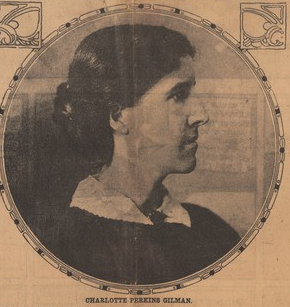
Photo published alongside Gilman’s article in The Sunday Herald Boston. From: http://pds.lib.harvard.edu/pds/view/17454836 seq. 12. -
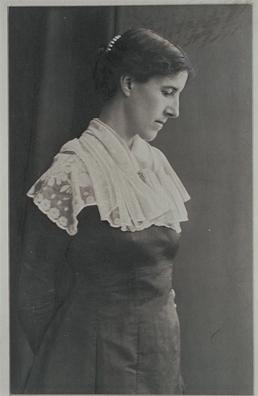
Portrait of Gilman. Photo from: https://library.artstor.org/#/asset/SCHLES_130746986&fs -
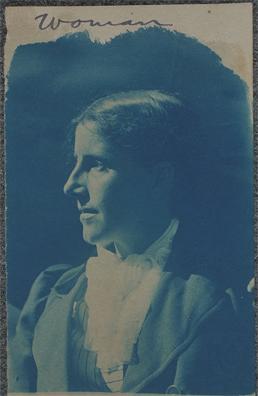
Printed portrait. From: https://library.artstor.org/#/asset/SCHLES_130733985&fs -
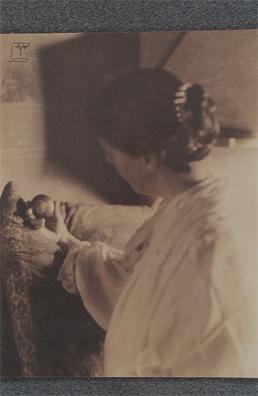
Photo from photoshoot collection. From: https://library.artstor.org/#/asset/SCHLES_130733987&fs -
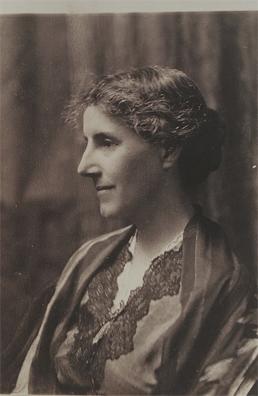
Portrait after the turn of the century. From: https://library.artstor.org/#/asset/SCHLES_130762915&fs -
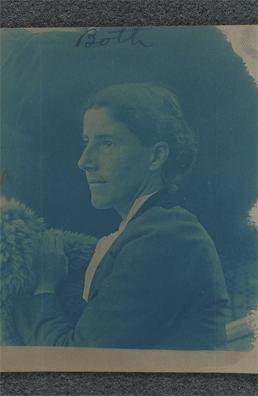
Portrait with two women cropped out. From: https://library.artstor.org/#/asset/SCHLES_130733984&fs -
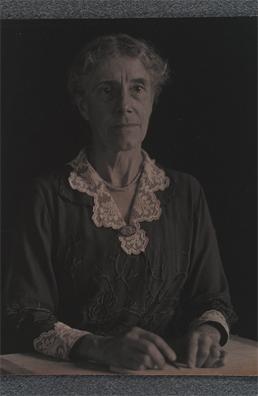
Portrait taken a year before Gilman’s 1935 suicide. From: https://library.artstor.org/#/asset/SCHLES_130733901&fs -
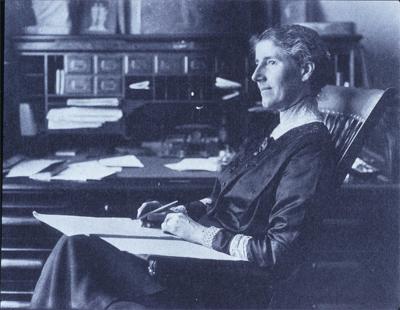
Photo of Gilman writing. From: https://library.artstor.org/#/asset/ARTSTOR_103_41822001764636&fs
References
- “Charlotte Perkins Gilman feminist writer and philosopher.” Artstor, library.artstor.org/asset/ARTSTOR_103_41822001764636
- Gilman, Charlotte Perkins. The Abridged Diaries of Charlotte Perkins Gilman. University Press of Virginia, 1998.
- —-Charlotte Perkins Gilman’s In This Our World and Uncollected Poems, edited by Gary Scharnhorst, and Denise D. Knight, Syracuse University Press, 1994. ProQuest Ebook Central, https://ebookcentral.proquest.com/lib/stocktonnj-ebooks/detail.action?docID=3410104.
- —-The Living of Charlotte Perkins Gilman: an Autobiography. Edited by Ann J. Lane, The University of Wisconsin Press, 1990.
- —-“What is Feminism?” The Sunday Herald Boston, 1860-1935. Papers, 1846-1961, Folder 1o. Printed articles, 1891-1926, n.d., http://pds.lib.harvard.edu/pds/view/17454836 seq. 12.
- Charlotte Perkins Gilman: Optimist Reformer, edited by Jill Rudd, and Val Gough, University of Iowa Press, 1999. ProQuest Ebook Central, https://ebookcentral.proquest.com/lib/stocktonnj-ebooks/detail.action?docID=859290.
